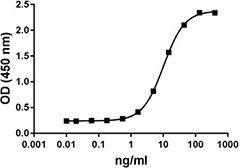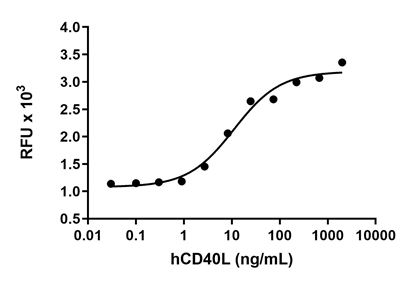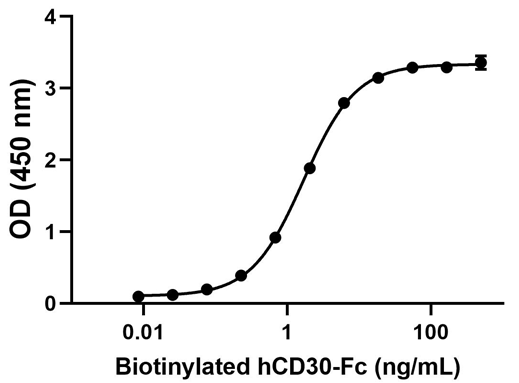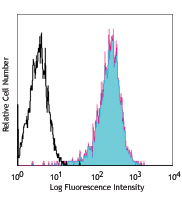- Regulatory Status
- RUO
- Other Names
- Tumor necrosis factor ligand superfamily member 8 (TNFRSF8), CD153, CD30LG, CD30 antigen ligand, tumor necrosis factor ligand 3A, TNLG3A
- Ave. Rating
- Submit a Review
- Product Citations
- publications

-

Human CD30L binds to immobilized recombinant human CD30 (2 µg/ml). The ED50 = 3 -18 ng/mL.
CD30L is a type II membrane glycoprotein belonging to the TNFL superfamily that includes CD27L (CD70), FasL (CD95L), CD120a (TNF-R1), CD120b (TNF-R2), OX40L (CD134L), 4-1BB ligand (CD137L), and CD40L (CD154). CD30 is a member of the TNF receptor superfamily, and it was originally identified as a cell surface antigen, Ki-1, on Hodgkin and Reed-Sternberg cells. Recombinant murine CD30L shares functional properties with CD40L in the regulation of murine B cell growth and differentiation in vitro. CD30L stimulated B cell proliferation, antigen-specific antibody production, and polyclonal immunoglobulin secretion in a cytokine-dependent manner; IL-4 and IL-5 are required for B cell proliferation and IL-2 and IL-5 for antigen-specific production. Interaction of CD30L, expressed in human B cells, with CD30+ T cells inhibits class switching and antibody production in human IgD+, IgM+ B cells. Cross-linking of CD30 ligand by a monoclonal antibody or by CD30-Fc fusion protein induced production of IL-8 by freshly isolated neutrophils. The signaling induced from the receptor to the cell expressing the transmembranal ligand has been denominated “reverse signaling.” CD30L/CD30 signaling seems to be involved in Th1 and Th2 cell responses and plays a key role in Th17 differentiation in mice. The CD30/CD30L signaling system has been implicated in the pathogenesis of several autoimmune and inflammatory conditions such as RA. Patients with RA have high levels of soluble CD30L (sCD30L) in sera and synovial fluid, and sCD30L inhibits CD30+T cell proliferation by inducing cell apoptosis. Mast cells are the predominant CD30L-positive cell in chronic inflammatory skin diseases such as psoriasis and atopic dermatitis, and CD30 and CD30L expression is upregulated in lesional skin in these conditions.
Product DetailsProduct Details
- Source
- Human CD30L, amino acids (Gln63-Asp234) (Accession # NP_001235) was expressed in CHO cells. The amino terminus contains 9His-2(SGGG)-IEGR-tag.
- Molecular Mass
- The 193 amino acid recombinant protein has a predicted molecular mass of approximately 21.8 kD. The DTT-reduced and non-reduced protein migrate at approximately 30 - 45 kD by SDS-PAGE. The predicted N-terminal amino acid is His.
- Purity
- > 95% by SDS-PAGE gel as determined by Coomassie stained SDS-PAGE.
- Formulation
- 0.22 µm filtered protein solution is in PBS, 1 mM EDTA, pH 7.2.
- Endotoxin Level
- Less than 1.0 EU per µg cytokine as determined by the LAL method.
- Concentration
- 10-25 µg sizes are bottled at 200 µg/mL.
- Storage & Handling
- Unopened vial can be stored between 2°C and 8°C for up to 2 weeks, at -20°C for up to six months, or at -70°C or colder until the expiration date. For maximum results, quick spin vial prior to opening. The protein can be aliquoted and stored at -20°C or colder. Stock solutions can also be prepared at 50 - 100 µg/mL in appropriate sterile buffer, carrier protein such as 0.2 - 1% BSA or HSA can be added when preparing the stock solution. Aliquots can be stored between 2°C and 8°C for up to one week and stored at -20°C or colder for up to 3 months. Avoid repeated freeze/thaw cycles.
- Activity
- Human CD30L binds to immobilized recombinant human CD30 (2 µg/ml) in a dose dependent manner as determined by functional ELISA. The ED50 = 3 -18 ng/ml.
- Application
-
Bioassay
- Application Notes
-
BioLegend carrier-free recombinant proteins provided in liquid format are shipped on blue-ice. Our comparison testing data indicates that when handled and stored as recommended, the liquid format has equal or better stability and shelf-life compared to commercially available lyophilized proteins after reconstitution. Our liquid proteins are verified in-house to maintain activity after shipping on blue ice and are backed by our 100% satisfaction guarantee. If you have any concerns, contact us at tech@biolegend.com.
Antigen Details
- Structure
- TNF ligand
- Distribution
-
Activated T cells, mainly CD8 T cells, malignant B-cell lines, neutrophils, mast cells, monocytes, and macrophages.
- Interaction
- Activated T cells, B lymphocytes surrounding the GCs, Th1, Th2, Th0, Tregs from RA patients.
- Bioactivity
- CD30L binds to immobilized CD30.
- Cell Type
- Embryonic Stem Cells
- Biology Area
- Cell Proliferation and Viability, Immunology, Stem Cells
- Molecular Family
- CD Molecules, Cytokines/Chemokines, Growth Factors
- Antigen References
-
1. Smith CA, et al. 1993. Cell 73:1349.
2. Gruss HJ, et al. 1994. Leukemia 8:2083.
3. Shanebeck KD, et al. 1995. Eur. J. Immunol. 25:2147.
4. Cerutti A, et al. 1998. Immunity 9:247.
5. Fischer M, et al. 2006. J. Clin. Invest. 116:2748.
6. Sun X, et al. 2010. J. Immunol. 185:2222.
7. Croft M, et al. 2013. Nat. Rev. Drug Discov. 12:147.
8. Tinazzi E, et al. 2014. Immunol. Lett. 161:236.
9. Barbieri A, et al. 2015. J. Immunol. Res. 2015:729654.
10. Ward-Kavanagh LK, et al. 2016. Immunity 44: 1005. - Gene ID
- 944 View all products for this Gene ID
- UniProt
- View information about CD30L on UniProt.org
Related FAQs
- Why choose BioLegend recombinant proteins?
-
• Each lot of product is quality-tested for bioactivity as indicated on the data sheet.
• Greater than 95% Purity or higher, tested on every lot of product.
• 100% Satisfaction Guarantee for quality performance, stability, and consistency.
• Ready-to-use liquid format saves time and reduces challenges associated with reconstitution.
• Bulk and customization available. Contact us.
• Learn more about our Recombinant Proteins. - How does the activity of your recombinant proteins compare to competitors?
-
We quality control each and every lot of recombinant protein. Not only do we check its bioactivity, but we also compare it against other commercially available recombinant proteins. We make sure each recombinant protein’s activity is at least as good as or better than the competition’s. In order to provide you with the best possible product, we ensure that our testing process is rigorous and thorough. If you’re curious and eager to make the switch to BioLegend recombinants, contact your sales representative today!
- What is the specific activity or ED50 of my recombinant protein?
-
The specific activity range of the protein is indicated on the product datasheets. Because the exact activity values on a per unit basis can largely fluctuate depending on a number of factors, including the nature of the assay, cell density, age of cells/passage number, culture media used, and end user technique, the specific activity is best defined as a range and we guarantee the specific activity of all our lots will be within the range indicated on the datasheet. Please note this only applies to recombinants labeled for use in bioassays. ELISA standard recombinant proteins are not recommended for bioassay usage as they are not tested for these applications.
- Have your recombinants been tested for stability?
-
Our testing shows that the recombinant proteins are able to withstand room temperature for a week without losing activity. In addition the recombinant proteins were also found to withstand four cycles of freeze and thaw without losing activity.
- Does specific activity of a recombinant protein vary between lots?
-
Specific activity will vary for each lot and for the type of experiment that is done to validate it, but all passed lots will have activity within the established ED50 range for the product and we guarantee that our products will have lot-to-lot consistency. Please conduct an experiment-specific validation to find the optimal ED50 for your system.
- How do you convert activity as an ED50 in ng/ml to a specific activity in Units/mg?
-
Use formula Specific activity (Units/mg) = 10^6/ ED50 (ng/mL)














Follow Us